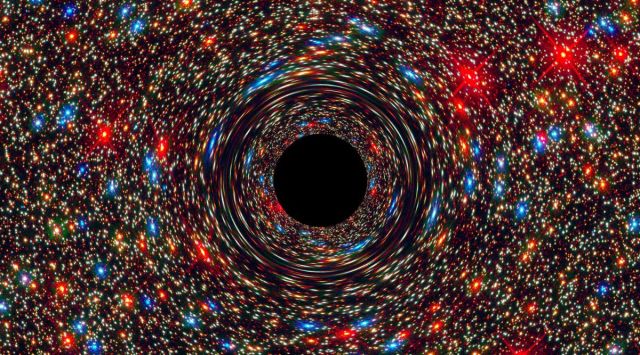 This representative image shows a cumpuer-simulated black hole at the core of a galaxy. (NASA, ESA, and D. Coe, J. Anderson, and R. van der Marel (STScI))
This representative image shows a cumpuer-simulated black hole at the core of a galaxy. (NASA, ESA, and D. Coe, J. Anderson, and R. van der Marel (STScI))
Supermassive black holes are terrifying cosmic entities that hold together entire galaxies with their gravitational power, sucking in and shredding anything that gets too close.
The new active supermassive black hole is at the centre of a galaxy CEERS 1019, which existed around 570 million years after the big bang, according to the University of Texas at Austin. Apart from the supermassive one, researchers also discovered two black holes that are “on the small side” and existed 1 billion and 1.1 billion years after the big bang.
CEERS 1019 is extremely old but that is not the most remarkable thing about it. It is quite lightweight, speaking in galactic terms. It weighs in at aroun 9 million solar masses, which is a lot less than other black holes that also existed in the early universe and were detected by telescopes.
the CEERS 1019 black hole is more like the one at the centre of the Milky Way, which is about 4.6 million times the mass of the Sun.
Despite its relatively diminutive size, the black hole existed so long ago that scientists are struggling to explain how it formed so soon after the universe began. The galaxy hosting the black hole seems to be inhaling as much gas as it can while also cranking out new stars.
WHAT IS JAMES WEB TELESCOPE
ITs INVENTION IS ALMOST AS SIGNIFICANT AS INVENTION OF TELESCOPE BY GALELIO
The James Webb Space Telescope is the largest, most powerful space telescope ever built. It will allow scientists to look at what our universe was like about 200 million years after the Big Bang. The telescope will be able to capture images of some of the first galaxies ever formed. It will also be able to observe objects in our solar system from Mars outward, look inside dust clouds to see where new stars and planets are forming and examine the atmospheres of planets orbiting other stars.
It is a premier observatory with a large infrared telescope that has an approximately 6.5-meter primary mirror.
SOME FINDINGS
SMACS 0723: Webb has delivered the deepest and sharpest infrared image of the distant universe so far .This deep field uses a lensing galaxy cluster to find some of the most distant galax ies ever detected.
WASP-96b (spectrum): Webb’s detailed observation of this hot, puffy planet outside our solar system reveals the clear signature of water, along with evidence of haze and clouds that previous studies of this planet did not detect.
Southern Ring Nebula: This planetary nebula, an expanding cloud of gas that surrounds a dying star, is approximately 2,000 light-years away. Here, Webb’s powerful infrared eyes bring a second dying star into full view for the first time. From birth to death as a planetary nebula, Webb can explore the expelling shells of dust and gas of aging stars that may one day become a new star or planet.
Stephan’s Quintet: Webb’s view of this compact group of galaxies, located in the constellation Pegasus, pierced through the shroud of dust surrounding the center of one galaxy to reveal the velocity and composition of the gas near its supermassive black hole. .
Carina Nebula: Webb’s look at the “Cosmic Cliffs” in the Carina Nebula unveils the earliest, rapid phases of star formation that were previously hidden.



Comments
Post a Comment